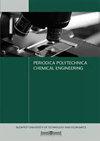Optimization of Cobalt Nanoparticles for Biogas Enhancement from Green Algae Using Response Surface Methodology
IF 1.8
4区 工程技术
Q3 ENGINEERING, CHEMICAL
引用次数: 2
Abstract
Organic matter may be converted to energy through various methods, but the most preferable one is the Anaerobic Digestion (AD), specifically for biogas production. In sustainable bioenergy production, it can undoubtedly be called one of the most widely used methods from the various feedstock. Over the past years, algae waste has become an increasingly acute environmental problem but luckily it can be used as feedstock to produce bioenergy. In order to improve the energy productivity of green algae, this study is focused on the introduction of cobalt (Co) nanoparticles (NPs) in the AD process. The concentration of Co NPs was optimized using response surface methodology (RSM). Mesophilic temperature range (25–45 °C), initial pH (5–9) and Co NPs dosage (0.5–2 mg/L) were selected as the independent variables for RSM. The results indicated that at optimized values (Co NPs concentration = 1 mg/L, initial pH = 7, and digestion temperature = 35 °C) produced the highest biogas yield of 298 ml. An experiment was carried out at optimized conditions to explore the effect on biogas production. The results showed that Co NPs had a positive influence on biogas yield. The low concentrations achieved higher biogas production as compared to higher ones. A maximum biogas yield of 678 mL is achieved by Co NPs (1 mg/L). AD performance was further evaluated by the modified Gompertz model. Different kinetic parameters were calculated. The values of the performance indicators confirmed that the mathematical model fitted well with experimental data.利用响应面法优化钴纳米颗粒对绿藻沼气的强化作用
有机物可以通过各种方法转化为能量,但最可取的是厌氧消化(AD),特别是沼气生产。在可持续生物能源生产中,它无疑是各种原料中使用最广泛的方法之一。在过去的几年里,藻类废物已经成为一个日益严重的环境问题,但幸运的是,它可以用作生产生物能源的原料。为了提高绿藻的能量生产率,本研究重点研究了在AD工艺中引入钴纳米颗粒(NPs)。采用响应面法(RSM)对Co NPs的浓度进行优化。选取中温范围(25 ~ 45℃)、初始pH(5 ~ 9)和Co NPs用量(0.5 ~ 2 mg/L)作为RSM的自变量。结果表明,在Co NPs浓度为1 mg/L、初始pH = 7、消化温度为35℃的优化条件下,产气量最高,为298 ml。结果表明,Co NPs对沼气产量有正向影响。与高浓度相比,低浓度的沼气产量更高。Co NPs (1 mg/L)的最大沼气产量为678 mL。采用改进的Gompertz模型进一步评价AD性能。计算了不同的动力学参数。性能指标的数值验证了数学模型与实验数据的拟合。
本文章由计算机程序翻译,如有差异,请以英文原文为准。
求助全文
约1分钟内获得全文
求助全文
来源期刊

Periodica Polytechnica Chemical Engineering
ENGINEERING, CHEMICAL-
CiteScore
3.10
自引率
7.70%
发文量
44
审稿时长
>12 weeks
期刊介绍:
The main scope of the journal is to publish original research articles in the wide field of chemical engineering including environmental and bioengineering.
 求助内容:
求助内容: 应助结果提醒方式:
应助结果提醒方式:


